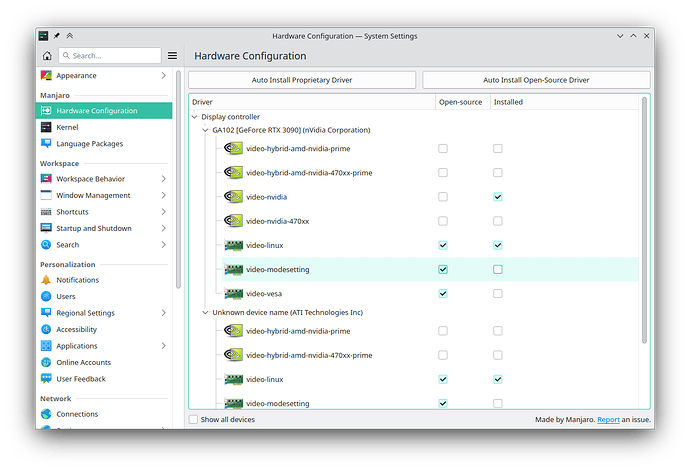I write this here because I think this is related both to kde/plasma and graphics. If this is in wrong forum, please inform me.
As stated in topic, changing tty does not mean it goes black, it shows my boot splash screen on all other than f1 witch is not the same as it going pitch black, ie the gpu outputs a signal, but no shell is loaded I guess?
Been trying to find anything about this but all I find is about ppl not having any output at all when trying ctrl+alt+f2.
System:
Kernel: 6.1.23-1-MANJARO arch: x86_64 bits: 64 compiler: gcc v: 12.2.1
parameters: BOOT_IMAGE=/@/boot/vmlinuz-6.1-x86_64
root=UUID=6995920c-67a8-4f61-a8a6-fc263b415d1f rw rootflags=subvol=@ quiet
splash resume=UUID=96dd6227-32fb-440a-8ba4-507515ed9f19
udev.log_priority=3 acpi_enforce_resources=lax
Desktop: KDE Plasma v: 5.27.4 tk: Qt v: 5.15.8 wm: kwin_x11 vt: 1 dm: SDDM
Distro: Manjaro Linux base: Arch Linux
Machine:
Type: Desktop System: Gigabyte product: X670 AORUS ELITE AX v: -CF
serial: <superuser required>
Mobo: Gigabyte model: X670 AORUS ELITE AX v: x.x
serial: <superuser required> UEFI: American Megatrends LLC. v: F8a
date: 03/22/2023
CPU:
Info: 12-core AMD Ryzen 9 7900X [MT MCP] arch: Zen 4 speed (MHz): avg: 3221
min/max: 3000/5733
Graphics:
Device-1: NVIDIA GA102 [GeForce RTX 3090] vendor: eVga.com. driver: nvidia
v: 530.41.03 alternate: nouveau,nvidia_drm non-free: 530.xx+
status: current (as of 2023-03) arch: Ampere code: GAxxx
process: TSMC n7 (7nm) built: 2020-22 pcie: gen: 4 speed: 16 GT/s lanes: 16
bus-ID: 01:00.0 chip-ID: 10de:2204 class-ID: 0300
Device-2: AMD Raphael vendor: Gigabyte driver: amdgpu v: kernel
arch: RDNA-2 code: Navi-2x process: TSMC n7 (7nm) built: 2020-22 pcie: gen: 4
speed: 16 GT/s lanes: 16 ports: active: none empty: DP-1, DP-2, DP-3,
HDMI-A-1 bus-ID: 15:00.0 chip-ID: 1002:164e class-ID: 0300 temp: 45.0 C
Display: x11 server: X.Org v: 21.1.8 compositor: kwin_x11 driver: X:
loaded: amdgpu,nvidia unloaded: modesetting,nouveau alternate: fbdev,nv,vesa
dri: radeonsi gpu: nvidia,amdgpu resolution: 1920x1080~60Hz
API: OpenGL v: 4.6.0 NVIDIA 530.41.03 renderer: NVIDIA GeForce RTX
3090/PCIe/SSE2 direct-render: Yes
Network:
Device-1: Realtek RTL8125 2.5GbE vendor: Gigabyte driver: r8169 v: kernel
pcie: gen: 2 speed: 5 GT/s lanes: 1 port: e000 bus-ID: 0e:00.0
chip-ID: 10ec:8125 class-ID: 0200
Device-2: MEDIATEK MT7922 802.11ax PCI Express Wireless Network Adapter
driver: mt7921e v: kernel pcie: gen: 2 speed: 5 GT/s lanes: 1 bus-ID: 0f:00.0
chip-ID: 14c3:0616 class-ID: 0280
Drives:
Local Storage: total: 4.09 TiB used: 1.34 TiB (32.6%)
Info:
Processes: 468 Uptime: 6h 10m wakeups: 0 Memory: 30.5 GiB
used: 7.64 GiB (25.1%) Init: systemd v: 252 default: graphical
tool: systemctl Compilers: gcc: 12.2.1 clang: 15.0.7 Packages: 1309
pm: pacman pkgs: 1303 libs: 358 tools: pamac pm: flatpak pkgs: 6 Shell: Zsh
v: 5.9 default: Bash v: 5.1.16 running-in: yakuake inxi: 3.3.26
journald output when trying to change tty:
16 Apr 2023 00:03:44 pulseaudio Error opening PCM device front:2: No such file or directory
16 Apr 2023 00:03:44 plasmashell org.kde.plasma.pulseaudio: No object for name "alsa_output.pci-0000_01_00.1.hdmi-stereo"
16 Apr 2023 00:03:55 kwin_x11 kwin_core: XCB error: 152 (BadDamage), sequence: 8229, resource id: 17846696, major code: 143 (DAMAGE), minor code: 3 (Subtract)
16 Apr 2023 00:03:56 xembedsniproxy Container window visible, stack below
16 Apr 2023 00:03:56 kwin_x11 OpenGL vendor string: NVIDIA Corporation
16 Apr 2023 00:03:56 kwin_x11 OpenGL renderer string: NVIDIA GeForce RTX 3090/PCIe/SSE2
16 Apr 2023 00:03:56 kwin_x11 OpenGL version string: 3.1.0 NVIDIA 530.41.03
16 Apr 2023 00:03:56 kwin_x11 OpenGL shading language version string: 1.40 NVIDIA via Cg compiler
16 Apr 2023 00:03:56 kwin_x11 Driver: NVIDIA
16 Apr 2023 00:03:56 kwin_x11 Driver version: 530.41.3
16 Apr 2023 00:03:56 kwin_x11 GPU class: Unknown
16 Apr 2023 00:03:56 kwin_x11 OpenGL version: 3.1
16 Apr 2023 00:03:56 kwin_x11 GLSL version: 1.40
16 Apr 2023 00:03:56 kwin_x11 X server version: 1.21.1
16 Apr 2023 00:03:56 kwin_x11 Linux kernel version: 6.1.23
16 Apr 2023 00:03:56 kwin_x11 Requires strict binding: no
16 Apr 2023 00:03:56 kwin_x11 GLSL shaders: yes
16 Apr 2023 00:03:56 kwin_x11 Texture NPOT support: yes
16 Apr 2023 00:03:56 kwin_x11 Virtual Machine: no
16 Apr 2023 00:03:56 kwin_x11 GlideConfig::instance called after the first use - ignoring
16 Apr 2023 00:03:56 kwin_x11 BlurConfig::instance called after the first use - ignoring
16 Apr 2023 00:03:56 kwin_x11 ZoomConfig::instance called after the first use - ignoring
16 Apr 2023 00:03:56 kwin_x11 WindowViewConfig::instance called after the first use - ignoring
16 Apr 2023 00:03:56 kwin_x11 SlidingPopupsConfig::instance called after the first use - ignoring
16 Apr 2023 00:03:56 kwin_x11 SlideConfig::instance called after the first use - ignoring
16 Apr 2023 00:03:56 kwin_x11 OverviewConfig::instance called after the first use - ignoring
16 Apr 2023 00:03:56 kwin_x11 KscreenConfig::instance called after the first use - ignoring
16 Apr 2023 00:03:56 kwin_x11 DesktopGridConfig::instance called after the first use - ignoring
16 Apr 2023 00:03:56 plasmashell Could not find the Plasmoid for Plasma::FrameSvgItem(0x55866c295e50) QQmlContext(0x55866ba15640) QUrl("file:///usr/share/plasma/plasmoids/org.kde.plasma.notifications/contents/ui/global/Globals.qml")
16 Apr 2023 00:03:56 plasmashell Could not find the Plasmoid for Plasma::FrameSvgItem(0x55866c295e50) QQmlContext(0x55866ba15640) QUrl("file:///usr/share/plasma/plasmoids/org.kde.plasma.notifications/contents/ui/global/Globals.qml")
16 Apr 2023 00:03:56 plasmashell [GFX1-]: GFX: RenderThread detected a device reset in PostUpdate
16 Apr 2023 00:03:56 kcminit Initializing "/usr/lib/qt/plugins/plasma/kcms/systemsettings/kcm_mouse.so"
16 Apr 2023 00:03:56 kcminit Initializing "/usr/lib/qt/plugins/plasma/kcms/systemsettings/kcm_touchpad.so"
16 Apr 2023 00:03:56 kcminit kcm_touchpad: Using X11 backend
I have had this behavour since install but never really cared, but now I wanted to get OBS running and it didn’t ofc. And fixing it seems to involve removing and reinstalling drivers, and that might force me to use other ttys if something fails. Sooo, here we are.
Help please.
